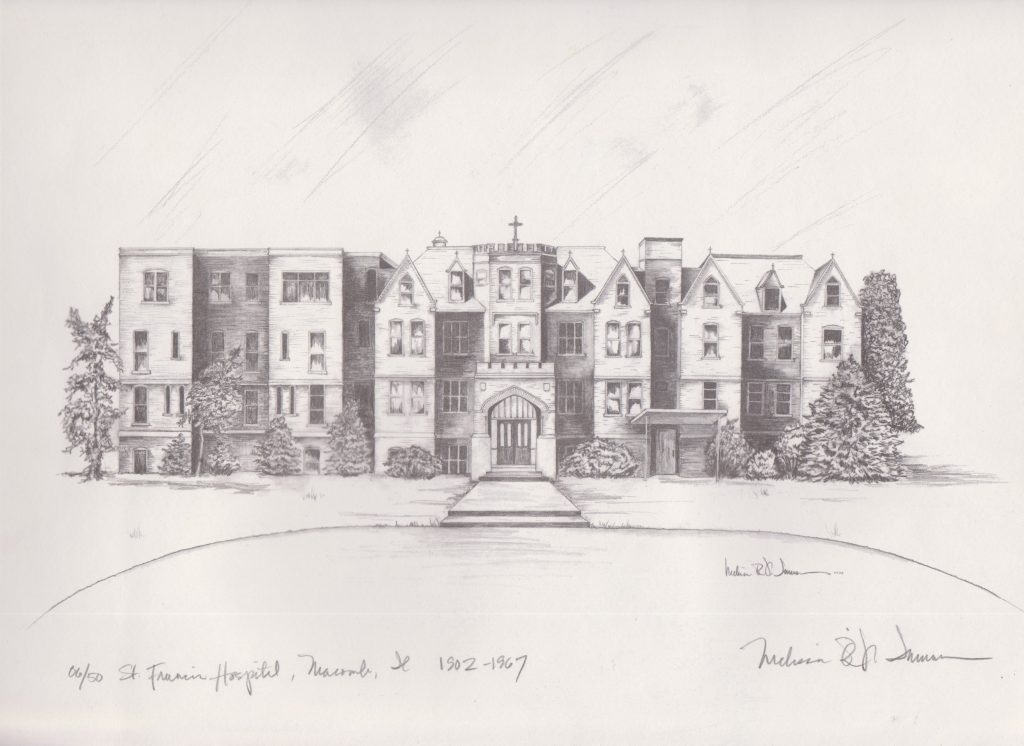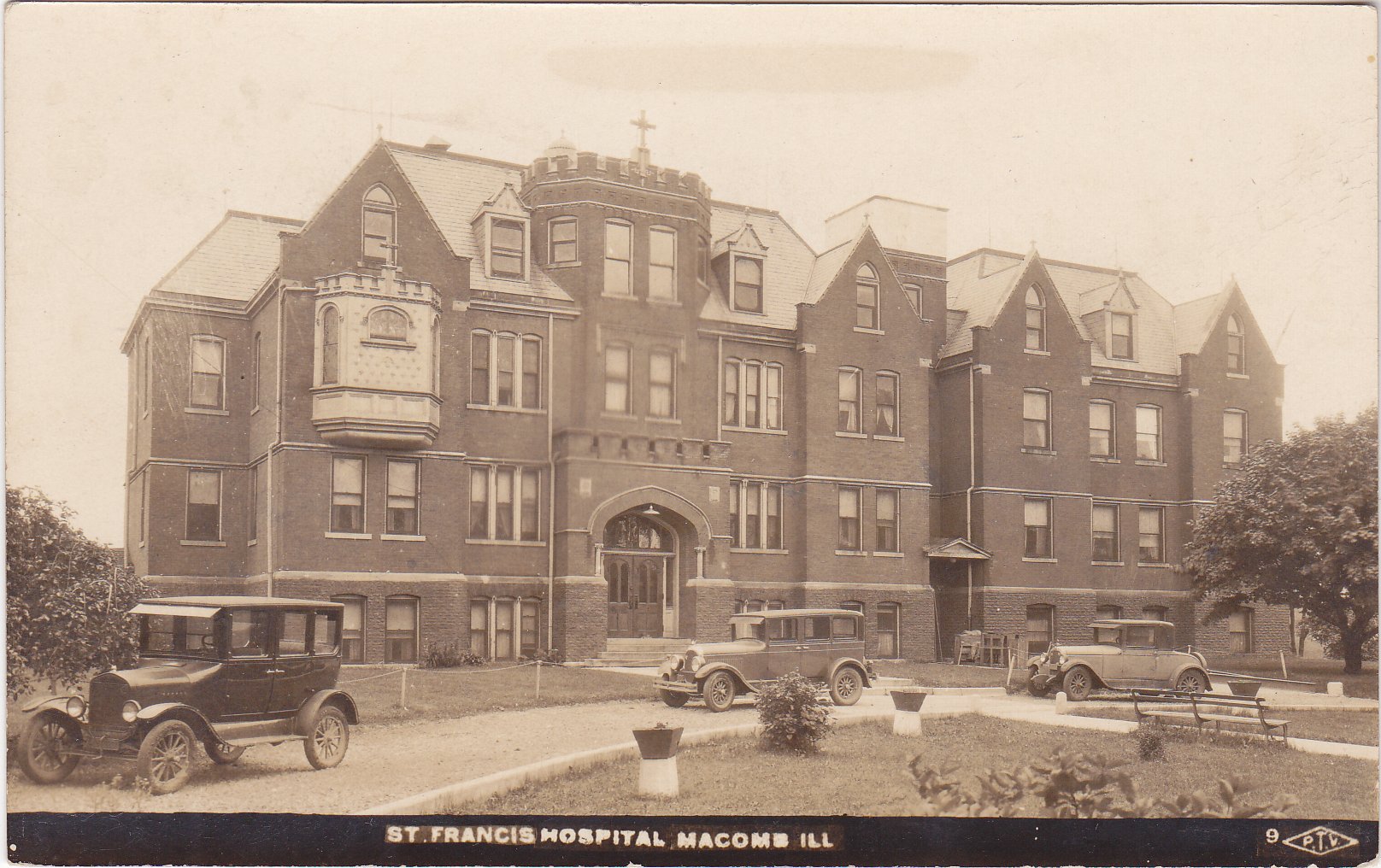By Marla Vizdal,
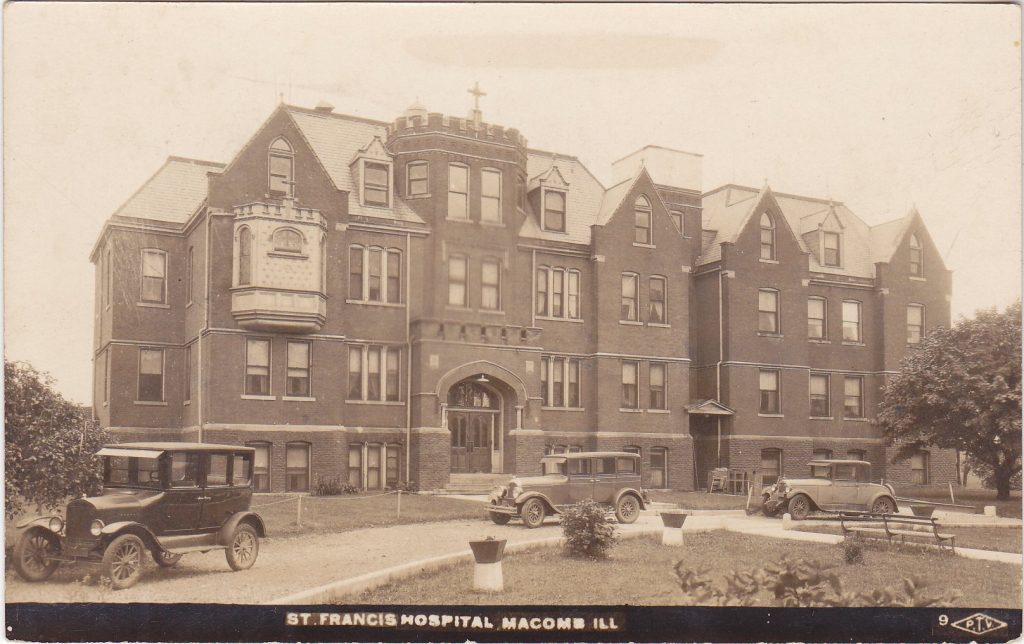
The St. Francis Hospital memorabilia in the Museum’s collection includes a number of items: postcards of the hospital (showing the building with each of its additions), the 1949 campaign booklet for a new hospital building, a scrapbook from one of the nursing students with photos of the nurses and their daily activities, and a print of Melissa Inman’s drawing of the hospital.
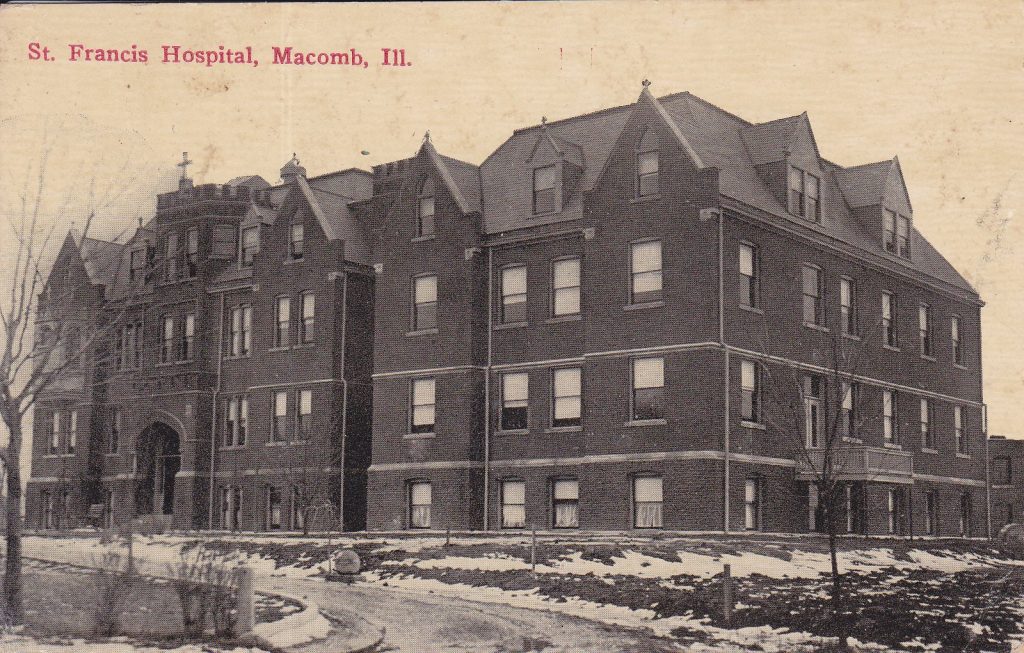
The first hospital in Macomb, the Phelps Hospital, was an idea that came about because of Marietta Phelps’ broken arm. Dr. S.C. Stremmel, who was her attending physician, suggested she contribute money to build a hospital to help serve the community’s needs. She followed Stremmel’s suggestion, and with additional contributions, a 14-room hospital was built on East Carroll Street in 1900. The hospital remained open until 1966.
St. Francis Hospital officially opened on April 6, 1903. The hospital was the result of Dr. Joseph Bacon’s vision of a larger hospital to better serve the community. He approached the Sisters of St. Francis in Clinton, Iowa, with a proposal and a monetary commitment. Bacon asked for their help to build a hospital in Macomb. They agreed, and the hospital was built under the watchful eye of Father Francis Lentz of St. Paul’s Church.
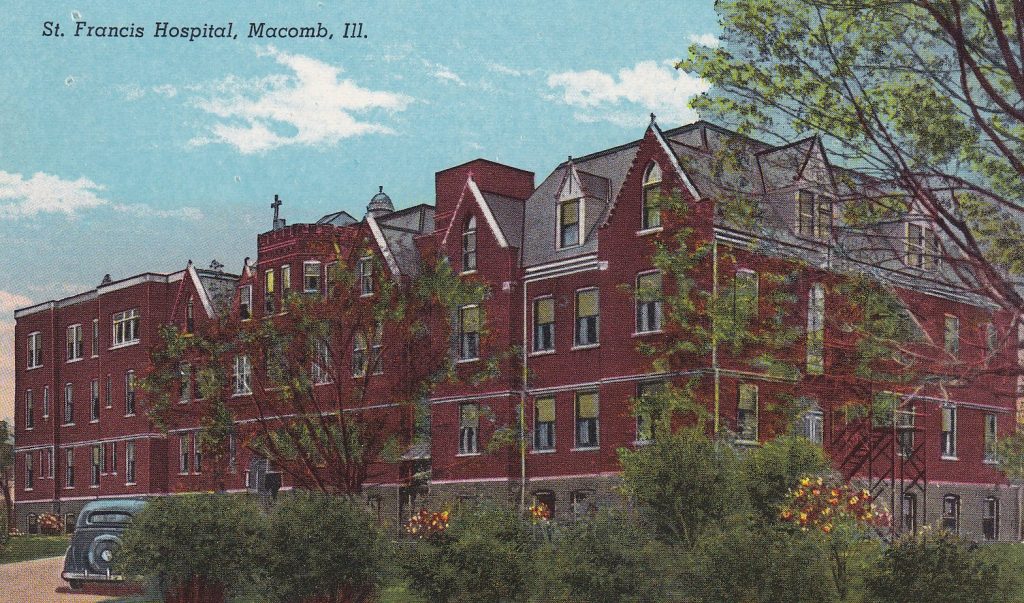
St. Francis Hospital was also a teaching facility, operated under the guidance of the Sisters of St. Francis, who managed the property. The hospital was a self-sufficient facility with its own large garden and barnyard of animals that would provide food for the patients. The profits made off of the garden and animals helped to subsidize the hospital. In addition to tending to the patients, the Sisters worked the gardens and took care of the animals, receiving their room and board in exchange.
The hospital was a state-of-the-art facility, originally built with three floors. An elevator was included in the plans so that patients could be easily transported from the ambulance entrance to the third floor, where the surgical and post-operative rooms were located. The first floor of the hospital included private rooms and administrative offices, while the second floor was the ward for the patients. The original building could house 25 patients, with their room costs ranging from $7 to $25 a week. In the first decade of service, hospital administration realized that they did not have enough beds for their patients. In 1912, an addition was added on the east side of the hospital, which doubled the available space needed for patients. The following year, a nursing school was added.
In the 1913 Bystander Macomb City Directory, an ad for the hospital promoted itself as “…there for everyone, treating all patients equally, regardless of race, religion, color, social standing or ability to pay.” The ad stated that “The hospital is primarily run for the benefit of poor people, or people of medium circumstances, hence the majority of our beds are furnished to patients at the actual cost of board and medicines, surgical dressings, etc. We furnish surgical and medical aid absolutely free of charge to all who take ward beds… so-called because several beds are placed in a large room.” The hospital was proud to state that “No distinction is made… between a ward patient and one who takes a private room.”
In 1909, Mary Johnston, a local nurse, opened the Lying-in Hospital on East Jackson Street. Prior to this time, the norm was that women birthed their children at home and that medical assistance came to them. Women now had an alternative place where they could go to have their babies and receive obstetrical care. The concept was something new. At St. Francis Hospital, it was not until 1919 that there were more than 20 births in a year recorded, and not until 1930 that 100 babies were born during the year.
The Lying-In Hospital’s existence was short-lived, and in 1912, Johnston sold it to Dr. Holmes, who renamed it Holmes Hospital. The hospital continued to specialize in obstetrics, operating as part of Phelps Hospital. By 1915, Holmes Hospital had severed it’s connections with Phelps Hospital and expanded its building and services. By 1922, as increasing needs prompted a plan for further expansion, Dr. Holmes realized that the responsibilities of the hospital had become too much for him. He decided to approach the Sisters of St. Francis, offering them the opportunity to purchase the hospital, which they accepted. Between the two facilities, St. Francis Hospital could offer care to 100 patients, but by 1927, the staff, patients, and equipment from the old Holmes Hospital were relocated to St. Francis Hospital. In 1928, the Holmes Hospital building was sold and subsequently made into an apartment building.
St Francis Nursing School offered an opportunity for young women to receive training in a profession. One of the artifacts featured in the display is a black scrapbook compiled by Margaret Louise Waddell, who attended the nursing school at St. Francis from 1927 to 1928. The book illustrates the experience of a young woman who is enjoying the beginning of a career. It includes photographs of her and her friends along with the Sisters. They are shown holding babies and assisting in the surgical suite. Young men are also seen in some photographs with their automobiles, traveling to new adventures with the young women. Within the scrapbook, there are newspaper clippings announcing engagements and marriages, along with handwritten invitations to parties.
Ms. Waddell was unable to complete her training due to an automobile accident that severely injured her leg. Her family reports that she walked with a limp for the rest of her life. Some say she was refused re-entry to the nursing school because of the limp.
In 1929, a second addition was built onto St. Francis Hospital, again increasing the amount of space at the disposal of the hospital. The hospital could now house 100 patients under one roof, where they would be given excellent care by the Sisters. The hospital would continue to train the Sisters and would offer state-of-the-art equipment to treat McDonough County’s ill and injured.
Services at the hospital continued to grow, as did the nursing program. When the United States entered into World War II, there was an increased need for the training of the U.S. Cadet Nurse Corps, so St. Francis stepped forward to help. A building was erected northwest of the hospital to provide classrooms and housing for the cadets. The building was named Thadeus Hall in honor of Sister Thadeus, one of the first sisters assigned to St. Francis Hospital. The building included classrooms and housing for the cadets. During the program’s existence, forty-five cadet nurses were trained for military service. The Cadet Nurse Corps training program was discontinued in 1948.

By 1949, St. Francis Hospital was operating over its bed capacity, often at 125 percent. The recommended safety capacity of a hospital at that time was no more than 70 percent, thus, a crisis situation was at hand. A Hospital Committee, chaired by Ned Haney, was formed to pursue a new hospital building for the region. A promotional booklet, appropriately titled “Dedicated To Service,” outlines a plan for a new five-story hospital complete with all the modern conveniences. The new hospital would, of course, include medical, surgical, obstetrical, and pediatric services, as well as a dental surgery department, but it would also include other specialized areas. There would also be a department to treat polio, scarlet fever, and other contagious diseases; there was also a psychiatric department.
Grants to cover half of the proposed $1.8 million hospital project were going to be applied for, and The Sisters of St. Francis had agreed to match dollar-for-dollar what the public would give ($450,000). The determining factor to go forth with the project, however, would be that the public would have to show their willingness to help. The promotional booklet was distributed to the community to do just that – show the community what the present hospital had to offer and what they needed for the future: a new and larger hospital.
Unfortunately, there was a lot of local discussion regarding the desire for a non-denominational community hospital (rather than a new St. Francis Hospital). A postcard referendum was mailed to registered voters in the county to determine what their preference was: a community hospital or a new St. Francis Hospital? The result was that a community hospital was preferred, and the decision to close St. Francis Hospital was made.
Local officials were able to convince the Peoria diocese to keep the hospital open until a new facility was built. McDonough District Hospital opened its doors to the public in 1958, and St. Francis closed in 1967 and was torn down in 1973.
Thadeus Hall still stands, having been converted into apartments.
The history of the physical building is documented in a 1994 print by Melissa Inman, showing the architectural details of the hospital that became a landmark for over 70 years. Along with postcards and photographs, it illustrates an institution that provided medical services to the community and a place that offered professional training and jobs. Each of the artifacts on display records its compelling history.
